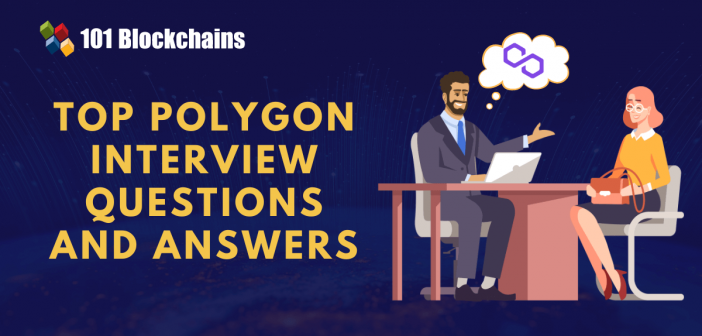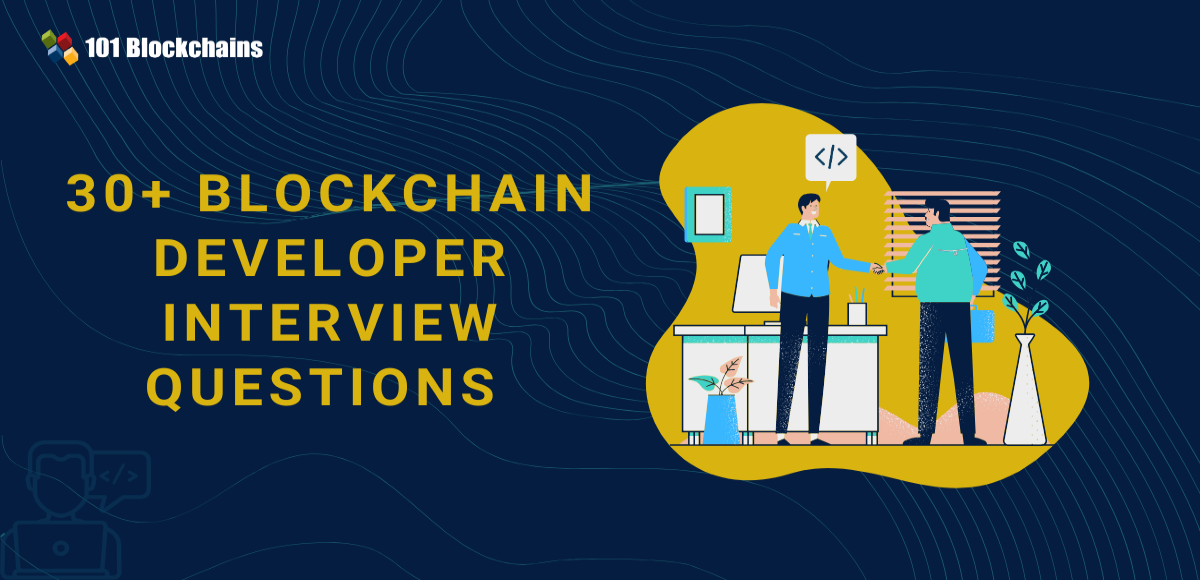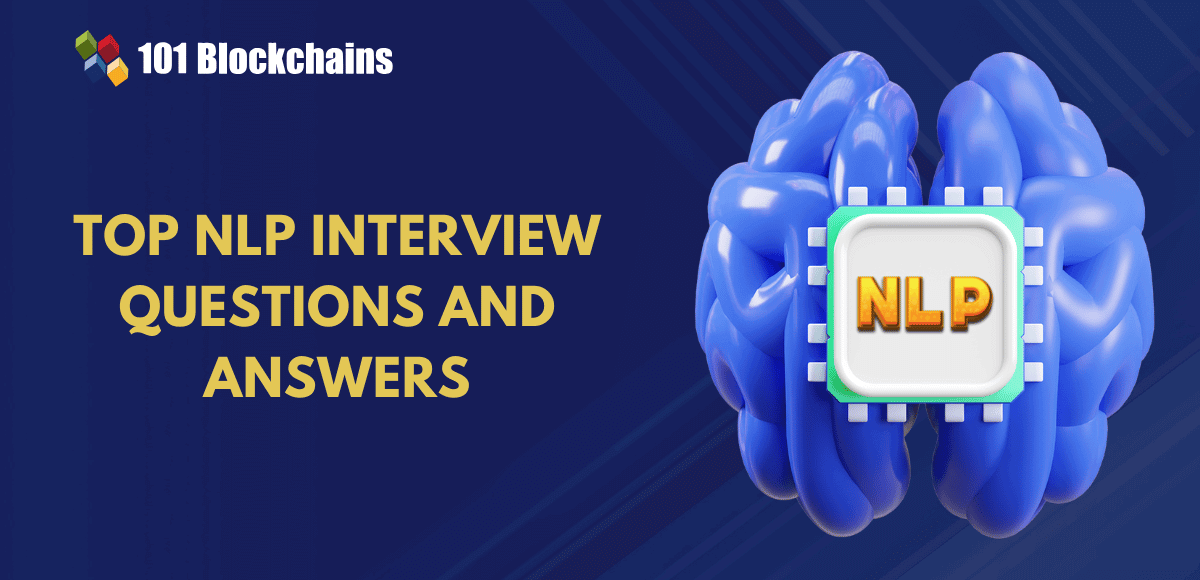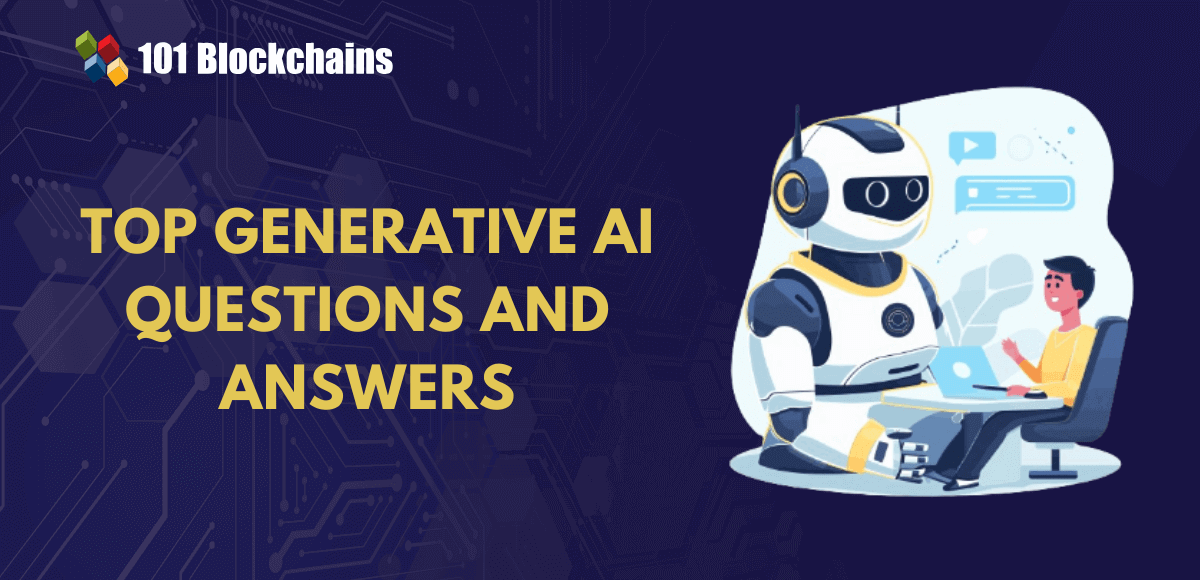Learn how blockchain truly works, master key definitions, and uncover what makes smart contracts so "smart." Dive into the fundamentals, gain valuable insights, and start your blockchain journey today!

- Interview Preparation
James Howell
- on March 31, 2023
Top 20 Polygon Interview questions and answers
Scalability has emerged as one of the prominent issues in the blockchain applications ecosystem right now. Developers have to struggle with problems of higher transaction fees and longer waiting times for transaction finality. The staggering rise in blockchain usage, specifically Ethereum, has created issues such as higher network congestion. Interestingly, layer 2 scaling solutions such as Polygon Network have emerged as crucial answers for addressing the problems of scalability and interoperability. Blockchain professionals and enthusiasts have been seeking Polygon questions and answers to learn more about its functionalities. Is Polygon really a revolutionary solution in the blockchain and web3 landscape? With over 500,000 transactions recorded on a daily basis in 2022, Polygon has successfully established a stronghold in the blockchain ecosystem.
The popularity of Polygon has also invited significant potential for career development. Polygon has opened up career roles for blockchain engineers, front-end developers, treasury managers, and platform business development roles. As a Solidity developer on Polygon, you can earn an average annual salary ranging from $50,000 to $240,000. Therefore, the top Polygon interview questions have become one of the top priorities of many professionals interested in building a career with Polygon. The following post outlines some of the notable interview questions about the Polygon blockchain.
Excited to develop a comprehensive understanding of Polygon? Enroll now in Polygon Fundamentals Course
Most Popular Polygon Interview Questions
Polygon has come up with the most promising solution to take the blockchain ecosystem forward, with interoperability and scalability as the prominent advantages. You need to find the best Polygon interview questions for building confidence to face interviews for Polygon-based job roles. It is also important to note that you can come across different types of questions in an interview for Polygon-based jobs.
Fundamental Polygon Interview Questions
The first thing an interviewer would test in candidates for Polygon blockchain jobs would be the fundamentals of Polygon. The regular Polygon questions might not seem difficult. However, you need to understand the best way to express your responses with articulate yet brief explanations. Here are the common questions on Polygon fundamentals you can face in an interview.
1. What is Polygon?
The first interview question about Polygon would obviously point to its definition. It is a collection of protocols aimed at addressing the problems of scalability on Ethereum. The Polygon network helps in resolving the scalability issues by managing transactions on separate Ethereum-compatible layer 2 blockchains. Polygon blockchain returns the transactions to the main Ethereum blockchain after processing, thereby reducing the burden on the Ethereum network. As a result, Polygon could help in ensuring faster transactions alongside lowering transaction costs.
Excited to develop a comprehensive understanding of Polygon web3 development? Enroll Now in Polygon Web3 Development Course!
2. Is Polygon different from MATIC?
Polygon was previously known as MATIC network. Such Polygon questions and answers test the candidate’s knowledge of the origins of the Polygon network. The project adopted the name Polygon in February 2021. The MATIC network provided only one specific offering in the form of plasma sidechains, which offer better security. However, the project expanded further and introduced new solutions, thereby leading to the new branding of Polygon Network. At the same time, Polygon has retained the name MATIC for its native cryptocurrency token.
3. How does Polygon work?
The Ethereum blockchain is the most preferred blockchain for developing smart contracts and dApps. However, it could process only a limited amount of transactions each second. You can answer such entries in the most popular Polygon interview questions by referring to the use of sidechains. Rather than processing transactions on the Ethereum mainnet, Polygon takes batches of transactions and processes them on another chain, running parallel to Ethereum. As a result, Polygon can offer the flexibility of handling around 65,000 transactions each second.
4. Who created Polygon?
Another notable addition among top Polygon interview questions would focus on testing your knowledge of the roots of Polygon. The Polygon network was created by a team of three people in 2017. The three co-founders of Polygon are Jaynti Kanani, Anurag Arjun, and Sandeep Naliwal. Over the years, Polygon has successfully garnered investors across the globe. In 2019, Polygon garnered around $450,000 as startup funding. The Polygon network also acquired almost $450 million in terms of funding from different investors. Mark Cuban is one of the prominent names in the list of Polygon’s growing list of investors.
5. Is Polygon an alternative to Ethereum?
The foremost highlight of the Polygon network is that it is not a competitor of Ethereum. Therefore, it is not likely to replace Ethereum. On the contrary, the primary objective of Polygon is the ability to create an infrastructure that could encourage the use of Ethereum. You can answer such choices in the best Polygon interview questions by referring to the ways in which Polygon depends on Ethereum for security. As a matter of fact, Polygon plays a crucial role in improving Ethereum as more users could access the Ethereum blockchain for dApps, DeFi, and NFTs.
Excited to learn the basic and advanced concepts of ethereum technology? Enroll Now in Ethereum Technology Course
Intermediate Polygon Interview Questions
After the basic questions, interviewers would dive deeper into technical questions to test your knowledge of Polygon. The intermediate-level Polygon questions and answers help in checking your understanding of the solutions, value advancements, and technical components. Here are some of the notable intermediate-level questions you can expect in an interview for Polygon job roles.
6. What are the competitive advantages of Polygon?
The primary idea underlying the origins of the Polygon or Matic network focused on achieving Ethereum scalability through Plasma technology. However, the founders of Polygon recognized the necessity of multi-chain scaling rather than relying on a one-size-fits-all solution. Such questions are different from regular Polygon questions and need to reflect on how the rebranding has changed the Polygon network. After the rebranding, the biggest competitive advantage of Polygon is that it has become an aggregator of different types of solutions for Ethereum scaling. As an aggregator, Polygon offers access to multiple scaling options, which can ensure better flexibility for dApp development.
Build your identity as a certified blockchain expert with 101 Blockchains’ Blockchain Certifications designed to provide enhanced career prospects.
7. Can you share some insights on the adoption of Polygon?
Polygon has become one of the most adopted solutions in the blockchain and web3 landscape. You can answer such queries among the most popular Polygon interview questions with references to facts. Polygon network has more than 500 dApps, along with many others in the development stages. In addition, the top web3 infrastructure providers such as Alchemy, Etherscan, Infura, and others can support the Polygon blockchain. As an Ethereum-compatible solution, the most prominent strength of Polygon is the community of Ethereum developers.
8. Will ETH 2.0 demolish the purpose of Polygon?
The transition of Ethereum to a Proof of Stake consensus mechanism with “The Merge” would solve many problems of Ethereum. You may have doubts about answering such choices in top Polygon interview questions, as ETH 2.0 can be more scalable than Ethereum. However, ETH 2.0 is likely to attract more user traffic, which can scale up to 50 or 100 times the existing traffic. As a result, Ethereum would have to encounter problems in offering the desired scalability, thereby implying the need for solutions like Polygon. In the long run, Ethereum would serve as the settlement layer, while Polygon would offer the scalability layer for business activities.
9. What are the layers in Polygon architecture?
The Polygon architecture includes four distinct layers. You can expect such regular Polygon questions in an interview to prove your knowledge of the technical design of Polygon. The Ethereum layer is the basic layer that leverages Ethereum with its Polygon chain. The security layer helps Polygon validators address the consensus mechanism of different chains. The Polygon Networks layer is the third layer, which includes the independent blockchain networks, with each network maintaining functions such as transaction processing and block production. The execution layer involves the execution of transactions in the Polygon ecosystem.
10. What are the solutions available in the Polygon ecosystem?
The Polygon ecosystem serves unique solutions for capitalizing on the power of the Ethereum blockchain. You can explain such Polygon questions and answers by reflecting on the five important solutions which define the Polygon network. The crucial solutions in the Polygon ecosystem include Polygon PoS, Polygon Supernets, Polygon Miden, Polygon zkEVM and Polygon ID.
11. What is Polygon PoS?
Polygon PoS or Proof of Stake network is one of the most popular protocols in the world, with more than thousands of dApps. Some of the top brands, such as Reddit, Stripe, and Starbucks, have been developing their web3 projects on the Polygon PoS network. You can also explain answers for such entries in the best Polygon interview questions with the benefits of the Polygon PoS network. It facilitates low cost, active community support, and EVM compatibility alongside the decentralized security of the Ethereum blockchain.
12. What is Polygon zkEVM?
Polygon zkEVM is an important component in the Polygon ecosystem and offers an innovative zero-knowledge scaling solution with the capabilities of Ethereum Virtual Machine. The answer for such additions among the most popular Polygon interview questions can also represent Polygon zkEVM as a layer 2 scaling solution that uses zero-knowledge proofs. Another simple description of Polygon zkEVM paints it as a ZK-rollup, which can support the transparent execution of smart contracts.
Curious to learn about the value advantages of ZKPs for blockchain security? Enroll now in Zero Knowledge Proofs (ZKP) Masterclass.
13. How does Polygon zkEVM work?
The working of Polygon zkEVM provides deeper insights into the capabilities of Polygon for achieving Ethereum scalability. The responses for such types of questions would be different from regular Polygon questions with the requirement of technical details. Polygon zkEVM works by emulating the Ethereum virtual machine and using verifiable zero-knowledge proofs as transaction validity proofs. In addition, Polygon zkEVM also serves the role of a state machine and implements necessary state changes.
14. What are the notable components in the architecture of Polygon zkEVM?
The important components in the architecture of Polygon zkEVM include the consensus contract, zkNode, zkProver and zkEVM Bridge. The consensus contract in Polygon utilizes the Proof of Efficiency and adds significant improvements. zkNode serves as the software required for the operations of zkEVM nodes. The zkProver helps in employing zero-knowledge technology for the creation of validity proofs. The final component, zkEVM Bridge, works as a smart contract for transferring assets between two layers.
Want to learn the basic and advanced concepts of Ethereum? Enroll in our Ethereum Development Fundamentals Course!
15. How does Polygon zkEVM improve the overall network efficiency?
The collection of intermediate-level Polygon questions and answers can also require candidates to reflect on the value advantages of solutions in the Polygon ecosystem. zkEVM employs different types of implementation strategies to guarantee efficiency. For example, the consensus contract offers incentives to efficient aggregators for participation in the process of generating proof. Another strategy adopted by zkEVM refers to the need for executing off-chain computations while retaining zk-proofs and essential data on-chain.
Advanced Polygon Interview Questions
The interview questions for Polygon jobs would also focus on the other innovative components of the Polygon ecosystem. Here are some of the advanced Polygon interview questions you should prepare for in 2023.
16. What is Polygon Miden?
Polygon Miden is a virtual machine that leverages zero-knowledge mechanisms. It has been created with application logic in the Rust programming language. Miden VM generates a STARK-based proof of execution automatically with the execution of every program. You can expand on answers for such entries in top Polygon interview questions by pointing out the flexibility for using the proofs. Anyone could use the STARK-based proof generated by Miden VM to verify the correct execution of the program and the contents.
Start learning Blockchain with World’s first Blockchain Skill Paths with quality resources tailored by industry experts Now!
17. What are the features of Miden VM?
The Miden VM has been tailored for generating zero-knowledge proofs alongside delivering the functionalities desired in regular virtual machines. Some of the notable features of Miden VM include flow control, subroutines or procedures, cryptographic operations, and a standard library. In addition, it is also compatible with native operations involving 32-bit unsigned integers and read-write random-access memory. Another important highlight of Polygon Miden refers to the support for non-deterministic programming.
18. How are Supernets relevant in the Polygon ecosystem?
Polygon Supernets is an important highlight of the Polygon ecosystem. It offers a customizable blockchain stack with different modules that you can use for developing forward-compatible and robust application-specific blockchains. You can respond to such entries among the best Polygon interview questions by referring to the unique advantages of Polygon Supernets. The facility of in-built EVM compatibility alongside additional features supports the efficiency of system architects and developers.
Start your blockchain journey Now with the Blockchains Fundamentals Course!
19. What is Polygon ID?
Polygon ID is also another concept you can come across in the most popular Polygon interview questions for professionals. It is a permissionless and decentralized identity framework suited for web3 as well as web2 applications. Polygon ID leverages the concepts of cryptography and self-sovereign identity or SSI to help individuals gain control over their identities. It can help users in proving their identity without disclosing private information.
20. How is Polygon ID useful for the Polygon network?
The most important advantage of Polygon ID refers to the assurance of privacy through the use of zero-knowledge proofs. In addition, Polygon ID can offer flexibility for on-chain and off-chain proof verification through smart contracts. Most important of all, Polygon ID helps in building trust within the Polygon community.
Excited to learn the concept of decentralized identity on existing digital ecosystems? Enroll in Decentralized Identity Fundamentals Course!
Conclusion
The outline of some of the top Polygon interview questions in different categories can help you prepare for Polygon job roles. One of the striking highlights of the Polygon network is that it is not a single solution. The Polygon ecosystem includes multiple solutions which can empower blockchain developers and users. As a trusted solution for the scalability problem on Ethereum, Polygon has emerged as a top name in the blockchain and web3 space. Therefore, job roles in Polygon blockchain have also climbed up to the top of job listings. Start learning more about the fundamentals of Polygon and prepare for a successful interview right now.






